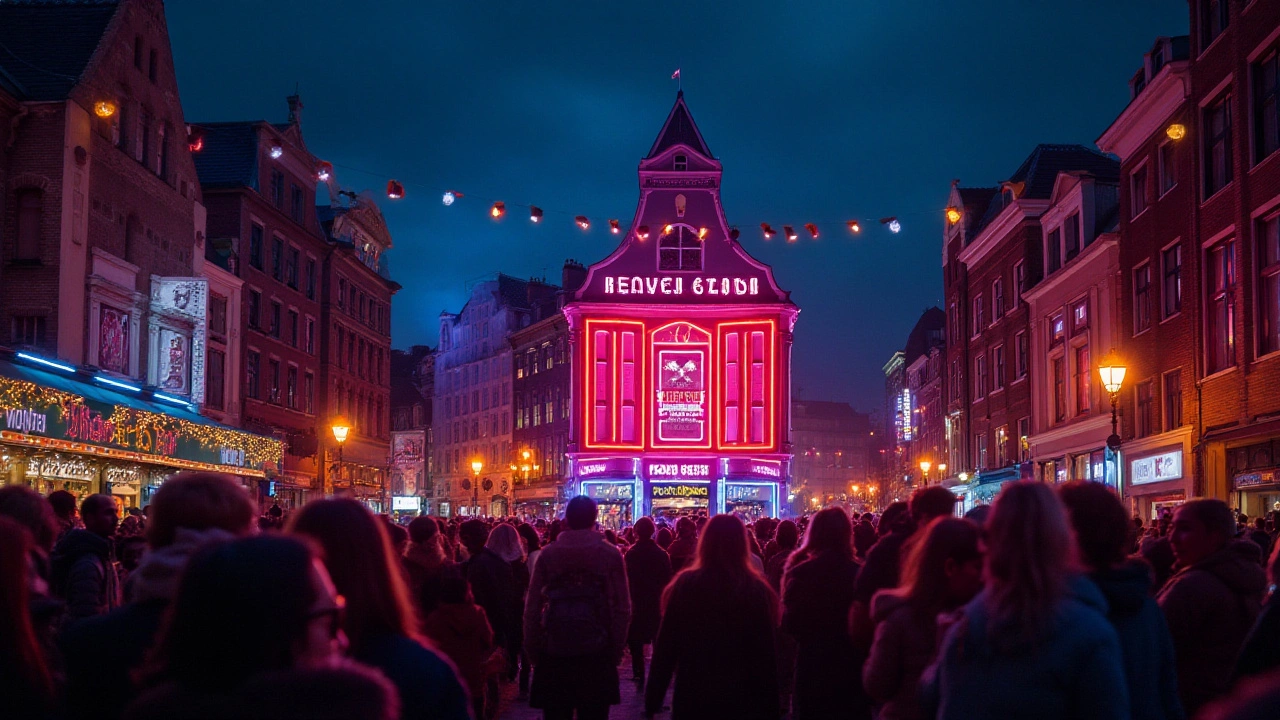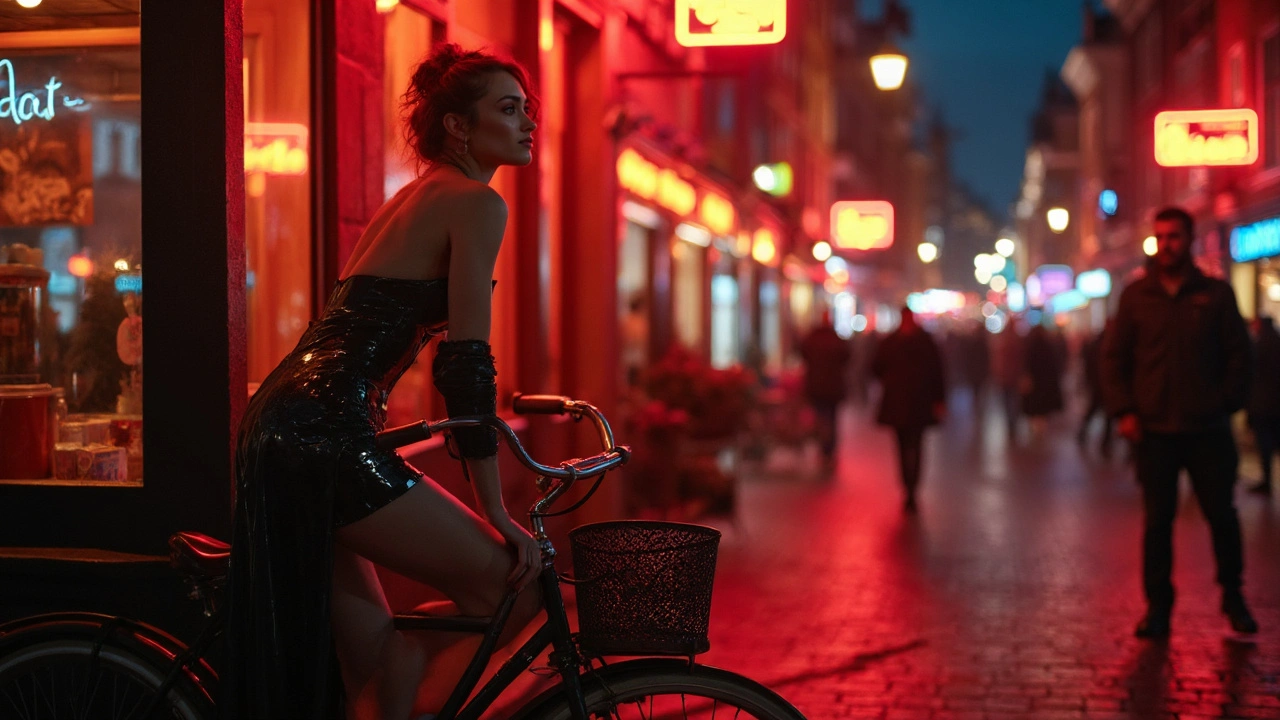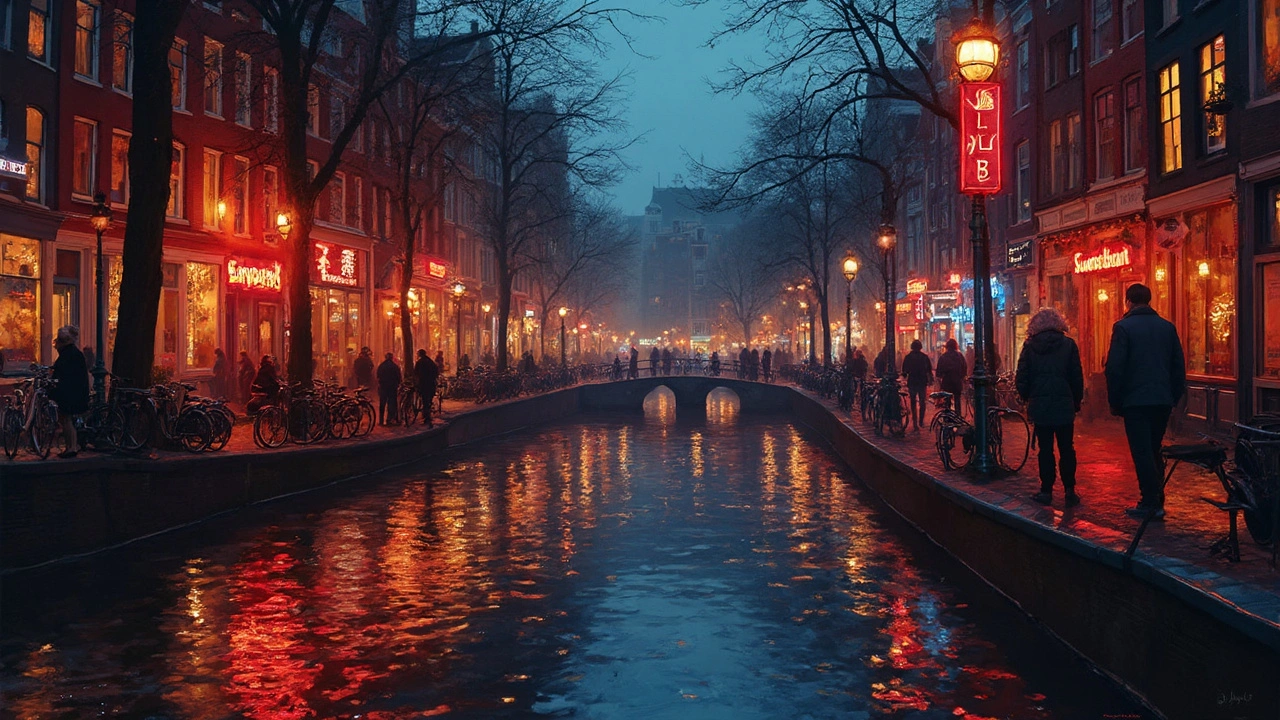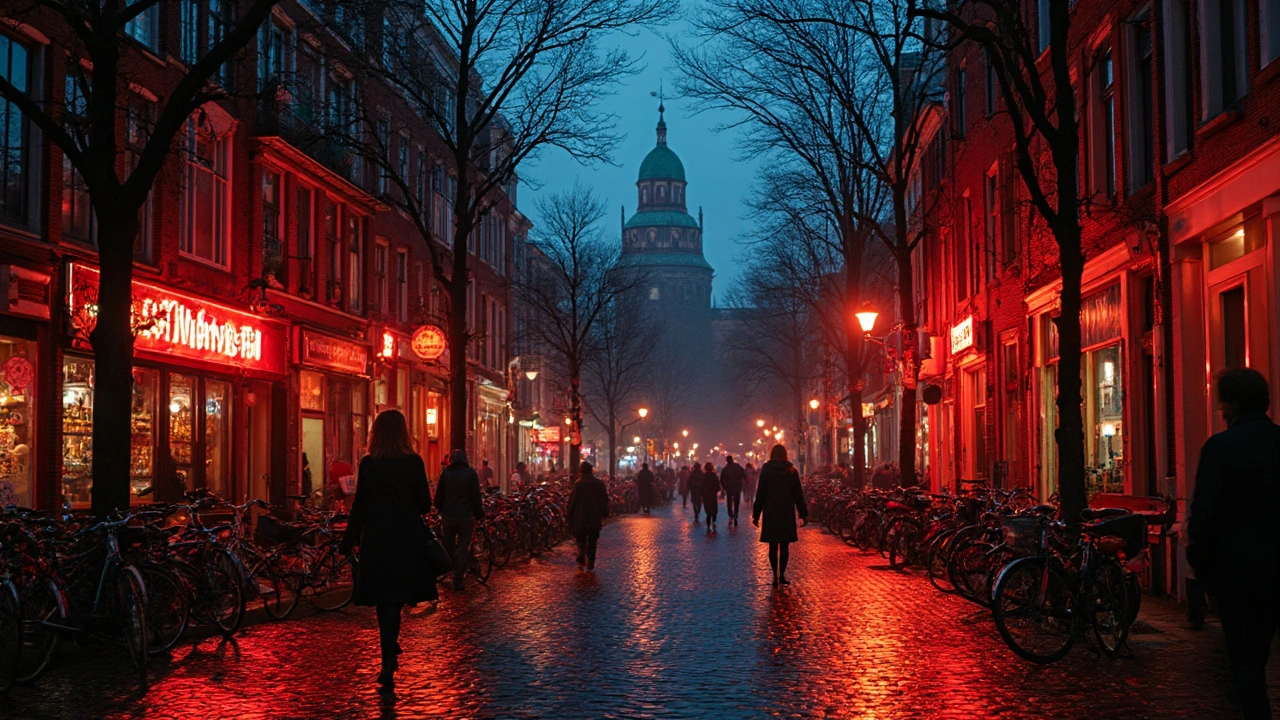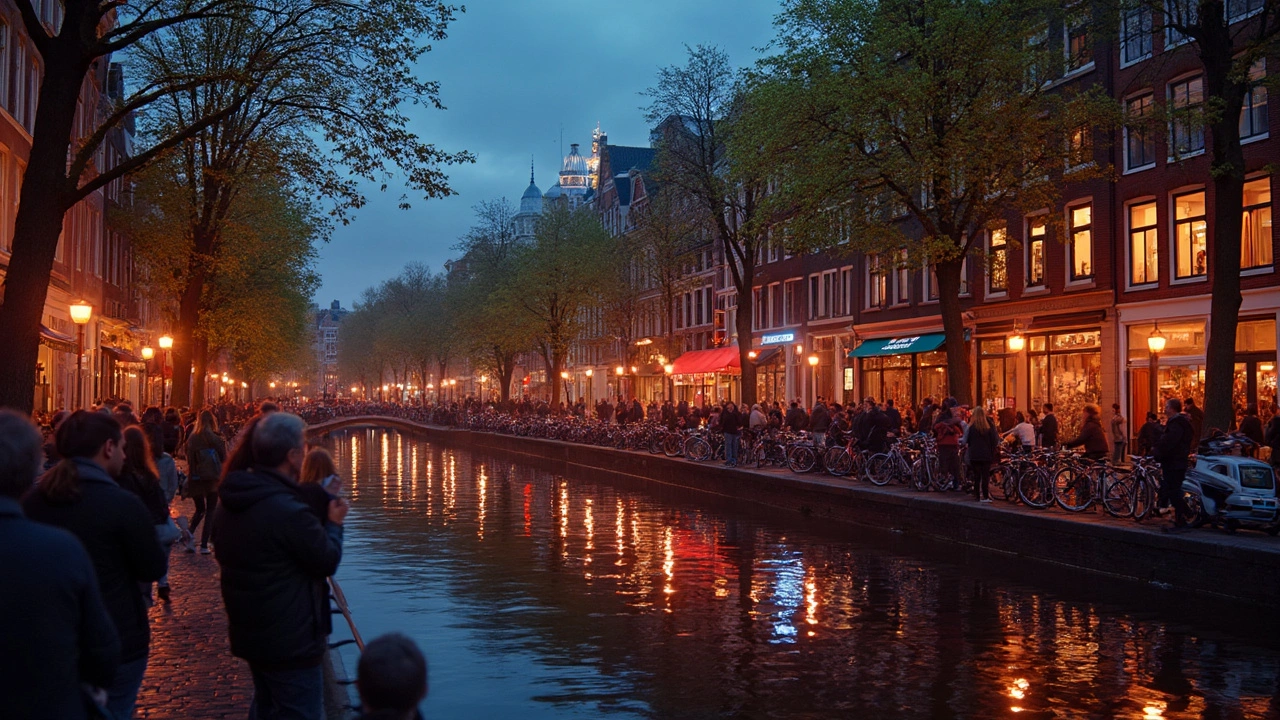
Ask anyone about Amsterdam, and the Red Light District usually pops up fast. For a lot of tourists, this is the place they’ve read about, where legal prostitution is part of daily life, right in the heart of the city. But walking through those buzzing streets—especially around Oudezijds Achterburgwal and through alleys like Trompettersteeg—can feel overwhelming if you don’t know what to expect.
First thing to understand: yes, prostitution is legal in Amsterdam, and it’s regulated. That means the women you see behind the famous glass windows are self-employed, pay taxes, and have the same basic rights as any other worker in the city. There are rules both for their safety and yours, and trust me, it’s important to know them before you just start snapping photos or wandering into the wrong spot.
If you’re thinking you’ll find chaos or anything unsafe, you might be surprised. The Red Light District, known locally as De Wallen, is actually one of the safest places in Amsterdam at night, patrolled heavily by police and full of CCTV cameras. It’s right in the historic core, steps from Dam Square and Central Station, so you can’t really miss it. But it’s not one big party—locals treat the area pretty casually, and there’s a strong code of conduct, both written and unwritten, that keeps things respectful.
- How Legal Prostitution Works in Amsterdam
- What to Expect in the Red Light District (De Wallen)
- Rules, Etiquette, and Tourist Dos-and-Don’ts
- Safety, Scams, and Practical Tips
- Behind the Windows: How it All Operates
- Shops, Tours, and Local Landmarks to Check Out
How Legal Prostitution Works in Amsterdam
Legal prostitution in Amsterdam isn’t some free-for-all; it’s handled with a ton of rules, checks, and paperwork. The city hall has strict codes that anyone working in the Amsterdam red light district has to follow. Window prostitution has been legal here since 2000, but regulated brothels have existed way longer than that. Workers need to be at least 21 years old, officially registered, and get regular health checks. They rent their windows—usually paying landlords or brothel operators for a shift—and set their own hours and prices.
Amsterdam’s city council rolled out a licensing system for brothels and window rentals. All business owners have to pass background checks—if they break the rules, they lose their license. The idea is to protect sex workers from pimps, human trafficking, and unsafe conditions. As a tourist, you can book a window legally and safely, but everything should be clear and above board.
"Legalization meant we could step out of the shadows and demand our rights," says Amsterdam sex worker advocate Mariska Majoor, founder of the Prostitution Information Center (PIC).
Here’s how the basics stack up:
- Prostitutes set their own rates and choose their clients—they’re not forced.
- Windows, brothels, and clubs operate under city licenses; surprise inspections happen all the time.
- There are free legal resources and medical services for workers—PIC and P&G292 are the main help centers.
- No advertising for underage or unlicensed sex work is allowed (the city’s strict on this).
If you’re wondering how common this is, check out these quick numbers:
| Fact | Data (2024) |
|---|---|
| Approximate number of windows in Amsterdam | 300 |
| Registered sex workers in Amsterdam | Over 2,500 |
| Minimum legal age | 21 |
| Brothels with a city license | ~100 |
The government keeps an eye on everything, from how windows are managed to health and safety rules. If you’re just in town for a visit, what matters most is to respect the workers, follow the rules, and remember you’re in someone’s place of work, not just a tourist attraction.
What to Expect in the Red Light District (De Wallen)
Walking into De Wallen—literally Amsterdam’s oldest neighborhood—you’ll see more than the iconic red-lit windows that everyone talks about. This area stretches from Centraal Station down to Zeedijk and includes little canals, cobblestone alleys, and plenty of old churches and bars crammed into tight spaces. The vibe honestly changes by the hour: mornings are quiet and slow, late afternoons pick up with tour groups, and at night it’s crowded with everyone from locals to curious tourists.
The Amsterdam Red Light District is famous for its legal prostitution, but that’s not all you’ll find here. There’s a wild mix of sex shops, peep shows, cannabis 'coffeeshops,' pancake cafes, and quirky museums like the Erotic Museum and Red Light Secrets museum about prostitution. At any time, people of all ages and backgrounds wander through. It’s a safe area, even with the adult atmosphere, but don’t expect a wild party like you see in movies—it’s mostly laid back unless it’s a big event night, like King’s Day.
- The Windows: Women stand behind full-length windows, often outlined in neon red. If the curtain is closed, the room is in use or the person is on break. Many women are friendly if you’re respectful, but don’t knock or tap on the glass unless you’re serious and polite.
- Hours: Window working hours usually start around 11 a.m. until 3-4 a.m. on weekends. The area gets busiest between 9 p.m. and midnight.
- Clientele: Tourists, solo travelers, couples, groups—it’s all mixed. The area isn’t just for people looking to buy sex. Tons of tourists walk through for the atmosphere, museums, and a peek at the city’s famous tolerance.
If you’re into people-watching, you won’t be disappointed. There are often groups on guided tours, locals heading home on bikes, and business professionals stopping for dinner. The area has gotten stricter about tours—no loud groups after 7 p.m.—because the city wants to keep things less chaotic for workers and residents.
| Fact | Details |
|---|---|
| Number of Windows | About 300 in De Wallen, but fewer than years ago due to city regulations |
| Languages Spoken | Dutch, English, Spanish, German are common among workers |
| Photography | Photos and videos of windows/workers are strictly forbidden and enforced |
A lot of first-timers don’t know this, but police and 'hosts' (security staff hired by workers) keep a close eye on things. It’s a pretty safe area as a result, less risky than flashy nightlife spots in other big European cities. Still, keep your belongings close—it’s a tourist hot spot, so pickpockets sometimes take advantage, especially late at night.
Finally, you’ll notice just how normal everything feels here—sex work is treated like any other business. Locals might walk with their kids, there’s a supermarket in the middle of the district, and the shops close at regular times. For plenty of visitors, that’s the biggest surprise.
Rules, Etiquette, and Tourist Dos-and-Don’ts
If you’re new to the Amsterdam red light district, you need to know that the vibe is actually more respectful than rowdy. This is people’s workplace, not a theme park. One golden rule stands out above all: never take photos or videos of the window workers. Even pulling out your phone near the windows can get you in trouble. The city doesn’t play around—some working women have been known to come outside and throw water on people who try to sneak a picture.
Want to talk? Do it politely. You’re allowed to approach a window and talk to the worker (with respect and no pressure), but if they shake their head or lower the curtain, that’s a hard no. Don’t linger or stare. Some guys think it’s funny to gawk or make jokes, but you’ll just make everyone uncomfortable—and probably end up getting called out by locals. This isn’t tolerated in De Wallen.
As the City of Amsterdam puts it: “Everyone is welcome to walk through the district, but anyone who doesn’t respect privacy or the rules will be addressed.”
If you’re thinking of buying services, be clear and direct about what you want. Prices are usually clear—most windows start around €50 for 15-20 minutes, often cash only. Don’t start bargaining aggressively, and never try to negotiate after the act starts. Condoms are non-negotiable, both for safety and by law. Refusing one will get you shown the door instantly.
- Do keep your voice down—shouting or being loud draws the wrong kind of attention.
- Don’t drink too much before entering the district. Drunken tourists are top of the “least wanted” list for both workers and police. Bars like Excalibur on Warmoesstraat make for a good chill stop, but don’t overdo it before strolling.
- Stick to groups of two or three, not a roaming pack. Blocked streets and big groups upset the flow.
- Leave bikes parked outside the district—walking is way easier, and the narrow alleys get jammed with crowds already.
- Watch your belongings. Pickpockets go wherever tourists gather, and it’s easy to get distracted by everything going on.
Sometimes you’ll see guided tours, but the city is phasing these out during peak hours to reduce gawking. If you really want to learn more, visit the Prostitution Information Center on Enge Kerksteeg. They offer advice, background, and even events that give you genuine insight (without bothering anyone).
Bottom line: use common sense, don’t treat sex work like a circus, and pay attention to your surroundings. That’s the best way to blend in and not stand out in the Red Light District.

Safety, Scams, and Practical Tips
Walking around Amsterdam's Red Light District feels different from any other neighborhood, but it’s not a free-for-all. There are some real-world rules you’ll want to stick to—nobody wants to end their night with a fine or a run-in with security.
- No photos or videos of sex workers or their windows—ever. It’s strictly forbidden. Most windows have cameras, and if you try to sneak a shot, workers or security will call you out fast. Some tourists have had their phones grabbed and trashed—seriously.
- Watch your stuff. Pickpocketing happens, especially after dark when it's crowded, or during big events like King's Day. Keep your wallet zipped away and don’t flash cash at ATMs. Backpacks in front, not on your back.
- Only go inside if you’re a customer. Curious about what happens behind the windows? Don’t wander into brothels if you’re just gawking. Respect the privacy of both workers and clients.
- Avoid street dealers. People will offer you drugs, but these are illegal and almost always fake or dangerous. Amsterdam’s coffee shops are the only legit spot for cannabis—and even they have rules.
- Stay streetwise. The Red Light District is safe, but scams do happen. If someone tries to sell you a fake "VIP tour" or promises something that sounds too good, walk away.
There’s plenty of official info around. The city posts rules on signs, especially about photo bans and respect for workers—a visible reminder. If you need help or feel unsafe, police and special hosts (street guides wearing jackets marked 'host') patrol every day and night.
To give you an idea of what’s typical in a busy week, here’s a snapshot of some safety stats over a seven-day period, according to recent local news:
| Incident Type | Average Cases per Week |
|---|---|
| Pickpocketing | 23 |
| Photograph Fines | 10 |
| Fake Tour/Drug Scams | 6 |
If you’re new to this, it helps to stick to main streets like Oudezijds Voorburgwal and avoid dodgy alleyways after midnight, especially if you’ve had a drink or two. If you’re carrying bags or passports, leave them at your hotel or use one of Amsterdam’s central locker services nearby.
Finally, look for places marked with 'My Red Light' or official badges. They’re licensed and follow city rules, which protects both workers and visitors. If you get lost or feel uncomfortable, just ask a shop owner or one of the city hosts for directions—they’re used to tourists and happy to help.
Behind the Windows: How it All Operates
Ever wonder what’s really going on behind those bright red windows in Amsterdam’s Red Light District? It’s way more structured than most people think. Each window is actually a small workspace rented by a sex worker, and it's their livelihood. They pay around €120-€150 per shift (some work two shifts a day), and that's before taxes. The shifts usually run in two blocks: day (from 11:00 to 19:00) and night (from 19:00 into the early morning hours).
If you’re picturing a club or brothel, think again. These are independent, street-facing cabins—most in De Wallen and some in smaller spots like Singel or Ruysdaelkade. Each worker sets her own schedule, prices, and boundaries, which are always listed up front before any agreement. Most windows have curtains that get pulled shut when they’re with a client, signaling privacy. If curtains are open, it’s okay to approach and talk about services or prices. But remember, no always means no, and disrespect won’t get you anywhere.
- Most window workers speak English—and usually a few other languages, too.
- Cash is standard. Some, but not all, accept cards—so don’t count on it.
- Condom use is non-negotiable. This is required by law, not up for debate.
- Taking pictures or videos of the windows (or workers) is strictly forbidden. If you try, bouncers or locals will stop you fast.
Here’s a look at the basics of how things work for sex workers in Amsterdam:
| Aspect | Details |
|---|---|
| Window Rent (Per Shift) | €120-€150 |
| Typical Client Fee (15-20 min) | €50 (starting rate, may vary) |
| Hours Most Busy | Fri/Sat, 10pm-2am |
| Languages Spoken | Mostly English, Dutch, German, some Spanish/French |
The city regulates the Amsterdam window scene carefully. All workers must be 21 or older and registered with the local chamber of commerce. Health checks happen regularly, and the city even provides resources like free clinics and legal advice for workers. Police patrols are common, but it’s not aggressive—it’s all about keeping things safe for everyone.
For tourists, here’s a quick checklist before you approach any window:
- Respect the workers—smiles are fine, rude gestures or comments aren’t.
- Have your cash ready if you’re planning to do business.
- Never pull out your phone to take photos or film—seriously, you’ll get called out.
- If you just want to look, that’s fine—just do it from a distance and don’t block the walkway.
All said, the Red Light District is about consent, safety, and respect—for everyone involved. The system isn’t perfect, but the rules and oversight here are much tighter than in most other places. That’s a big reason why this part of town still draws such a steady stream of curious visitors every year.
Shops, Tours, and Local Landmarks to Check Out
You’ll find way more in the Red Light District than just the famous windows. This pocket of Amsterdam packs all kinds of shops, museums, and places you might not expect. Whether you’re here to learn, see something different, or grab a quick snack, there’s plenty worth a look.
Got a thing for quirky museums? The Red Light Secrets Museum on Oudezijds Achterburgwal gives you a look inside what it’s actually like to work behind a window. It’s honest, sometimes blunt, and pulls zero punches about the real life of a sex worker. For something more tongue-in-cheek, the Museum of Prostitution is right nearby, and the Erotic Museum throws in everything from historic photos to comic art.
Guided tours are huge here because walking with a local means you see stuff most tourists miss. Tours like Amsterdam Red Light District Tour or Secret Amsterdam Red Light Walk usually meet near Central Station, cover history (and some spicy stories), give you safety tips, and answer all sorts of awkward questions. Most tours are about 1.5 hours and, as of last year, range from €18 to €24 per person. Check before booking—some companies limit group sizes so you aren’t all crammed in one alley.
If you’re looking to shop, try Condomerie on Warmoesstraat. It’s probably the most famous condom shop in the city, full of genuine info and actually fun even if you’re not buying. For souvenirs that’ll get laughs back home, check out the munchies-friendly FEBO snack wall (where you buy croquettes from a vending machine), or swing by Tony’s Chocolonely for eye-popping Dutch chocolate bars.
The Red Light District also serves up solid food and drinks. Legends like Cafe de Oude Kerk sit right across from the oldest church in Amsterdam, giving you a place to chill just steps from the action. There’s always street food around—stroopwafels, Dutch fries, or even late-night pizza if you’re hitting the area after dark.
For a quick overview of iconic local stops and what they’re known for, check this handy table:
| Spot | What You'll Find | Address |
|---|---|---|
| Red Light Secrets | Prostitution Museum & window tour | Oudezijds Achterburgwal 60 |
| Condomerie | Unique condoms & safe sex info | Warmoesstraat 141 |
| FEBO | Snack wall (Dutch croquettes) | Multiple locations |
| Café de Oude Kerk | Historic pub, local beers | Oudekerksplein 42 |
| Tony’s Chocolonely Super Store | Fair trade chocolate bars | Oudebrugsteeg 15 |
Remember, photos of the workers or windows are a no-go, but you’re welcome to snap all the food, shops, and museum walls you want. The vibe can shift a ton—afternoons are pretty chill, while weekend nights turn wild. If crowds aren’t your thing, early evenings on weekdays are usually the sweet spot for looking around and actually seeing stuff.

